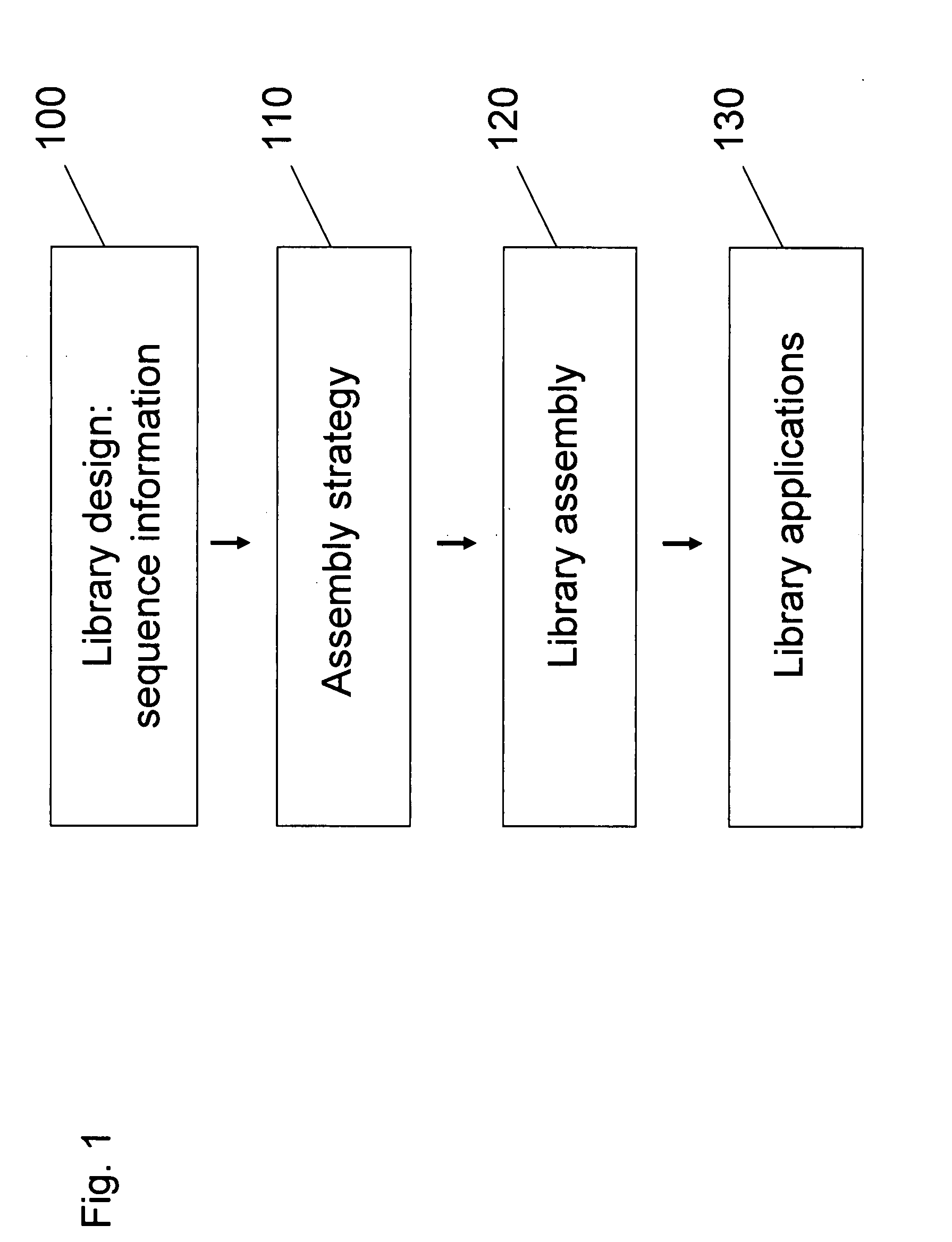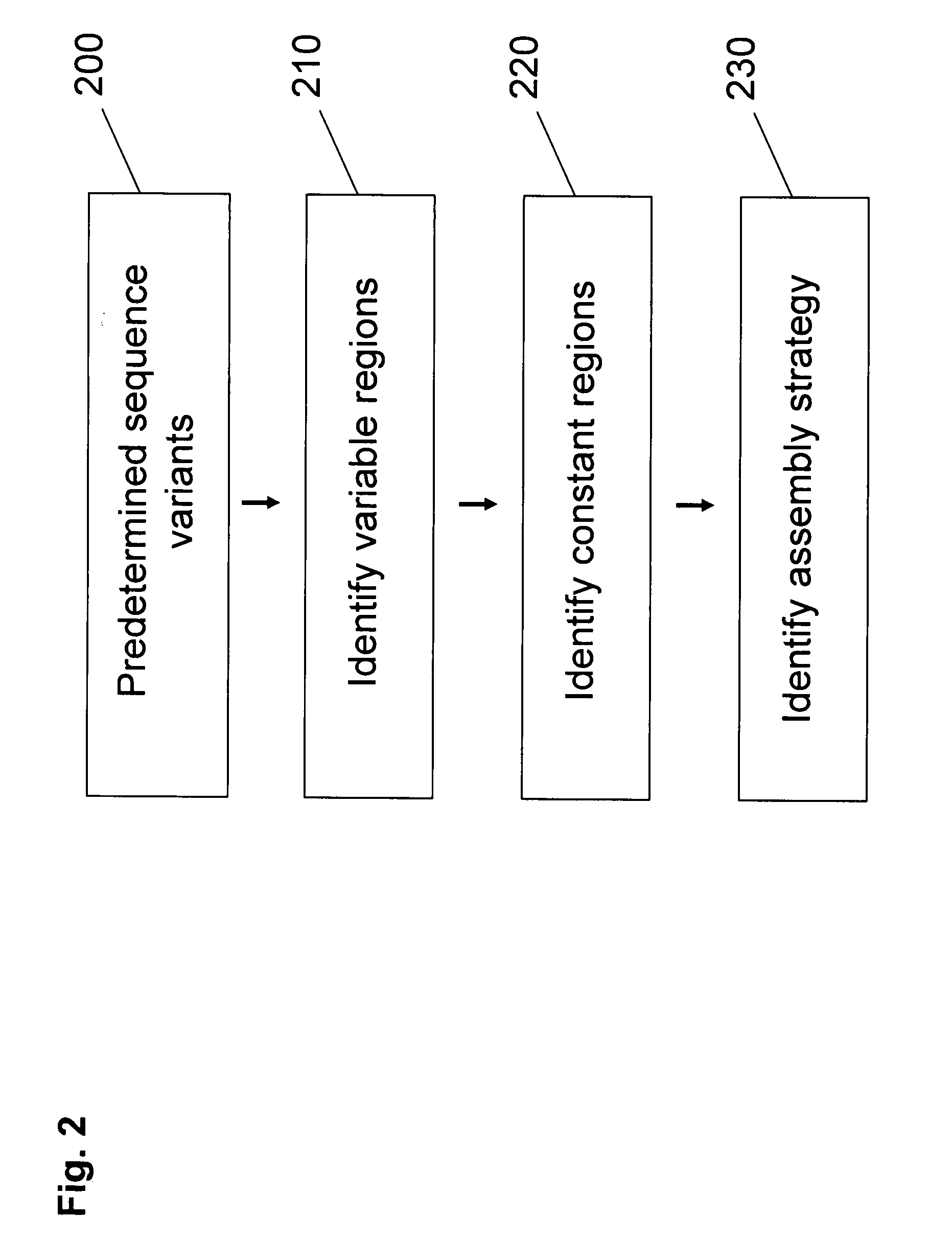Libraries and their design and assembly
a technology of nucleic acid libraries and design methods, applied in the direction of nucleotide libraries, library creation, etc., can solve the problems that the current method of assembling small numbers of variant nucleic acids cannot be scaled up in a cost-effective manner to generate large numbers of specified variants, and achieve low stability, poor solubility, and high immunogenicity
- Summary
- Abstract
- Description
- Claims
- Application Information
AI Technical Summary
Benefits of technology
Problems solved by technology
Method used
Image
Examples
example 1
Design and Construction of Library for Four-Fragment Peptide Variants
[0221]In this example, a target nucleic acid encodes a peptide that contains four variable regions separated by intervening constant or invariable sequences. Accordingly, the full length target sequence is conceptually divided into four corresponding fragments, each of which consists of a variable region, flanked by an invariable intervening sequence. In the instant example, the intervening invariable sequence is a constant residue (‘const.’) flanking each of the variable fragment on both sides. Thus, the objective is to generate a library that represents substantially all combinations of desired variants by combining nucleic acids for each of the four variable fragments.
[0222]In the instant example, the four variable fragments are referred to as fragment A, fragment B, fragment C and fragment D, in the amino→carboxyl direction. In the instant example, a constant residue is present (as an invariable sequence) betwe...
example 2
Reduction of Number of Construction Oligonucleotides Involving Two Adjacent Variable Positions: Comparison of Conventional and Improved Methods
[0243]An example of variant library construction involving adjacent variable positions is illustrated in FIG. 3C and FIG. 3D. A 2.5 kb fragment of nucleic acid contains five positions sought to be varied. These are at positions 120, 123, 1497, 1500 and 1611. Two pairs of variable sites are closely positioned with each other (positions 120 and 123; and positions 1497 and 1500), whereas the fifth variable position (position 1611) is sufficiently distant. For each of the five variant positions, there is a possibility of 40 different variants, totaling a library size of 405=1.0×108. According to a conventional method of variant library construction (FIG. 3C), for the variant positions that are next to each other (positions 120 and 123; positions 1497 and 1500), it would be necessary to synthesize 1,600 variant oligonucleotides for each region to ...
example 3
Error-Corrected Library Construction
[0246]A library of mutant variants for a 759 bp nucleic acid was generated. Target nucleic acid sequences contained up to 12 point mutations at defined amino acid residues. For each of the point mutation sites, two variants were considered (i.e., wild type and mutant). Thus, the total number of variants having a discrete combination of mutations at various residues of the 12 mutation sites can be calculated as follows:
(2)12=4,096
[0247]In this experiment, each of the target nucleic acids containing various mutations was assembled from a plurality of oligonucleotides. The oligonucleotides were synthesized on a chip-based platform and eluted for assembly. All variants were constructed in a single reaction pool.
[0248]Two parallel experiments were carried out to assess the effect of errors contained in the assembly oligonucleotides on the representation in the resulting library.
[0249]In the first experiment, errors introduced during oligonucleotide syn...
PUM
 Login to View More
Login to View More Abstract
Description
Claims
Application Information
 Login to View More
Login to View More - R&D
- Intellectual Property
- Life Sciences
- Materials
- Tech Scout
- Unparalleled Data Quality
- Higher Quality Content
- 60% Fewer Hallucinations
Browse by: Latest US Patents, China's latest patents, Technical Efficacy Thesaurus, Application Domain, Technology Topic, Popular Technical Reports.
© 2025 PatSnap. All rights reserved.Legal|Privacy policy|Modern Slavery Act Transparency Statement|Sitemap|About US| Contact US: help@patsnap.com



